1000 - 900 BCE
King Solomon
As the reign of King David came to an end, his son Solomon was appointed king in his stead. Solomon was deeply aware of the great responsibility that befell him. In a heartfelt prayer to G-d, Solomon did not ask for power or wealth, but for wisdom and knowledge to lead God’s great nation.
Not only did God grant him wisdom, but Solomon became the wisest man to have ever lived. Due to his noble and humble request, he was also granted wealth, prosperity, and the expansion of the Kingdom beyond anyone before or after him.
His kingship was known throughout the four corners of the ancient world and many kings, queens, and dignitaries travelled from far and wide to meet (with) him.
King Solomon, famously known for his wise judgments, sharp intuition and discernment, left a rich legacy of wisdom and guidance in writings like the Book of Proverbs and the Songs of Solomon that are still relevant and applicable today. Even the very pensive Book of Ecclesiastes is ascribed to King Solomon.
City of David Megalim Institute
Timeline of King Solomon
c. 982 BCE Bathsheba gives birth to Solomon.
c. 970 BCE David dies and Solomon becomes King.
c. 930 BCE Solomon dies. His kingdom is divided into the 10 “lost” tribes of Israel under King Jeroboam and the 2 Southern tribes of Judea and Benjamin under King Rehoboam.
c. 925 BCE The Pharaoh Shoshenq (Shishak) invades Israel and raids the Temple of Solomon.
This is the Timeline of King Solomon:
c. 982 BCE Bathsheba
gives birth to Solomon.
c. 970 BCE David dies and
Solomon becomes King.
c. 930 BCE Solomon dies.
His kingdom is divided into the House of Judah which consists of the southern
tribes of Judah and Benjamin under his son King Rehoboam, and the House of
Israel under King Jeroboam (from the tribe of Ephraim), the remaining northern
tribes that would ultimately be exiled during the Assyrian onslaught of the
land and become known as the 10 lost Tribes.
c. 925 BCE
The Pharaoh Shoshenq (Shishak) invades Israel and raids the Temple of
Solomon.
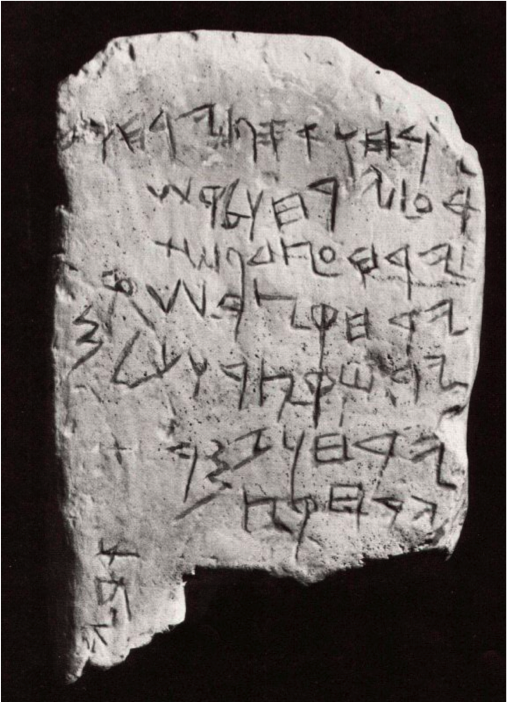
Replica, Israel Museum, Jerusalem
The Gezer Calendar,
10th Century BCE
Ecclesiastes 3:1-2
King Solomon wrote:
For everything there is a season, and a time for every matter under heaven:
A time to be born, and a time to die;
A time to plant, and a time to pluck up what is planted;
Gezer Calendar Inscription
Early Hebrew writing:
“Two months are planting
Two months are late (planting)
One month is hoeing flax
One month is barley-harvest”
The Gezer Calendar, circa 10th Century BCE, the time of King
Solomon, is a tablet discovered in 1908 during excavations at Gezer by the
Irish archaeologist R. A. Stewart Macalister. The tablet contains a list of
months according to the activities that occurred during each agricultural
cycle. The list begins on the Hebrew New Year and corresponds with the
agricultural cycles of the Biblical Festivals.
The Gezer
calendar inscription is in early Hebrew writing and reads as follows:
“Two
months are planting – corresponding to the time after Sukkot
Two months
are late (planting) - corresponding
to the time of the latter rain or
“Malkosh”
One month
is hoeing flax
One month
is barley-harvest" -
corresponding to the time of Passover and the counting of the Omer.
Ecclesiastes
3:1-2
King
Solomon wrote: For
everything there is a season, and a time for every matter under heaven:A time to
be born, and a time to die;A time to plant, and a time to pluck up what is
planted;
City of David Megalim Institute, Courtesy of George Blumenthal and the Gol Family
Solomon Is Anointed King c. 970 BCE
1 Kings 1:33-34, 45
The king (David) said to them, "Take my loyal soldiers, and have my son Solomon ride on my mule and bring him down to Gihon. Let the priest Zadok and the prophet Nathan anoint him there king over Israel, whereupon you shall sound the horn and shout, Long live King Solomon!"
"... and the priest Zadok and the prophet Nathan anointed him (Solomon) king at Gihon. Then they came up from there making merry, and the city went into an uproar. That’s the noise you heard.”
Kingship in ancient times was a highly pursued and
coveted position
and jealous ambitious aspirants from within the court constantly devised plans
to supplant the king and even kill off his descendants.
Absalom, one of King David’s sons, tried in a failed attempt to take the kingship from his
father. So when Nathan the prophet and Batsheva
(Solomon’s mother) heard that Adoniyah, King David’s eldest son was
planning to do the same, they reminded King David of his promise that Solomon
was to inherit the throne.
Watch the Megallim Video courtesy of George
Blumenthal and the Gol Family showing the suspenseful events that led to
ensuring Solomon’s place on the throne.
David's Charge to Solomon
by Rembrandt
1 Kings 2:1-3
When David’s life was drawing to a close, he instructed his son Solomon as follows: "I am going the way of all the earth; be strong and show yourself a man. Keep the charge of the LORD your God... as recorded in the Teaching of Moses...”
David's Charge to Solomon
by Rembrandt van Rijn
1 Kings 2:1-3
When
David’s life was drawing to a close, he instructed his son Solomon as follows:
"I am going the way of all the earth; be strong and show yourself a man.
Keep the charge of the L-RD your G-d... as recorded in the Teaching of
Moses...”
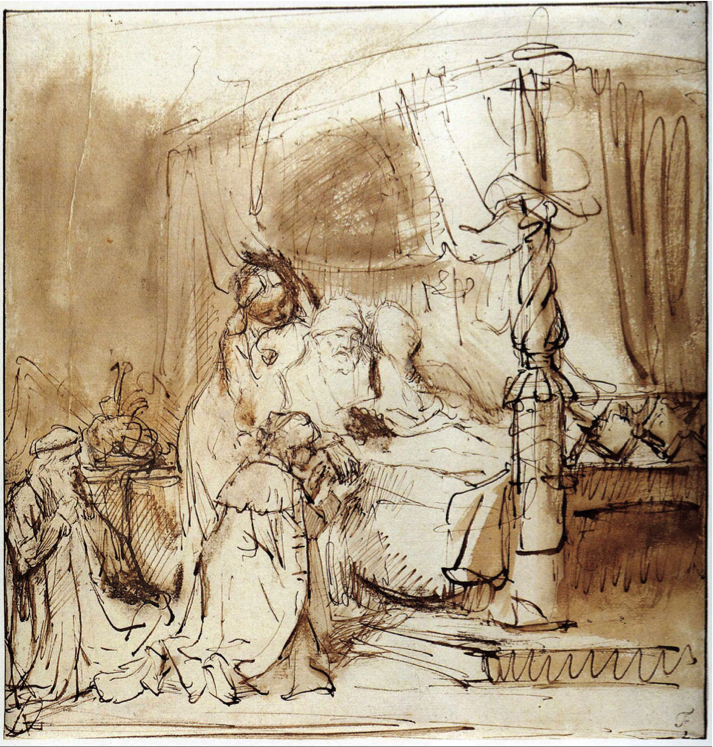
Devonshire Collections, Chatsworth
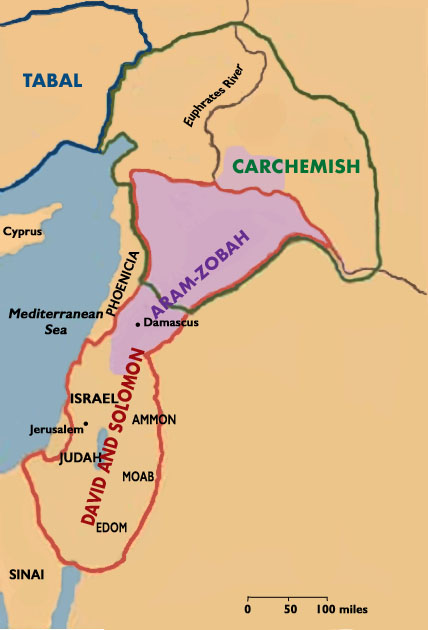
The United Monarchy
2 Samuel 8:11-12
King David dedicated these to the L-RD... all the nations he had conquered: from Edom, Moab, and Ammon...Zobah.
From 1200–900 BCE, regional empires flourished in the Near East. After the collapse of the Hittite Empire, Tabal arose from its remains, west of Carchemish. Aram-Zobah extended from modern Lebanon south to the Galilee and north to Damascus and the Euphrates. The realm of David and Solomon came to control the Aram-Zobah empire as well as territory from the Mediterranean to Edom, Moab and Ammon east of the Jordan and south to the Gulf of Aqaba (Eilat)
The United Monarchy
2 Samuel 8:11-12
King David dedicated these to the LORD... all the nations he had conquered: from Edom, Moab, and Ammon...Zobah.
From 1200–900 B.C.E., regional empires flourished in the Near East. After the collapse of the Hittite Empire, Tabal arose from its remains, west of Carchemish. Aram-Zobah extended from modern Lebanon south to the Galilee and north to Damascus and the Euphrates. The realm of David and Solomon came to control the Aram-Zobah empire as well as the territory from the Mediterranean to Edom, Moab and Ammon east of the Jordan and south to the Gulf of Aqaba.
Biblical Archaeology Society
The Israelite Temple of
King Solomon c.960 BCE
Because G-d refused David the task of building the Temple, due to the bloodshed during his battles in securing the land, the honour of the task fell on Solomon.
Solomon asked King Hiram of Tyre, who helped King David build his palace, to also partner with him in the building of the Temple as Tyre was not only known for its majestic Lebanon cedar trees but also their skillful stone masons.
The City of David Archives
Solomon Builds The First Israelite Temple to God
1 Kings 5:16-19
Solomon sent this message to Hiram:
“You know that my father David could not build a house for the name of the Lord… And so I propose to build a house for the name of the Lord my God…”
1 Kings 5:16-19
Solomon sent this message to Hiram: “You
know that my father David could not build a house for the name of the L-rd… And
so I propose to build a house for the name of the L-rd my G-d…”
City of David Megalim Institute, Courtesy of George Blumenthal
and the Gol Family

Library of Congress Prints and Photographs Division National
Museum of Beirut
Sarcophagus of Ahiram,
Phoenician King of Byblos,
c. 936 BCE
1 Kings 5:32
Solomon’s masons, Hiram’s masons, and the men of Gebal (Byblos) shaped them. Thus the timber and the stones for building the house were made ready.
Inscription from Sarcophagus
“Sarcophagus made by Ittobaal, son of Ahiram, king of Byblos, for Ahiram his father as a dwelling place for all eternity.”
1 Kings 5:32 Solomon’s masons, Hiram’s masons, and the men of Gebal (Byblos)
shaped them. Thus, the timber and the stones for building the house were made
ready.
In this picture archived by the United States Library of Congress is a
limestone sarcophagus from the Beirut Museum for Ahiram, King of Byblos, a site
on the Lebanese coast. A Phoenician inscription on the cover identifies the
receptacle as a “Sarcophagus made by Ittobaal, son of Ahiram, king of Byblos,
for Ahiram his father as a dwelling place for all eternity.” Ahiram likely
ruled in the tenth century BCE, a contemporary of King Solomon.
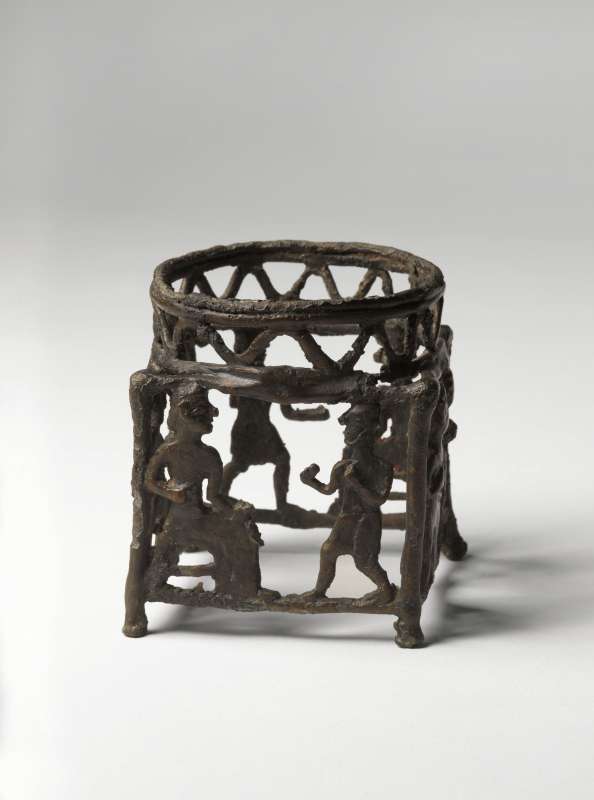
Laver stands
Laver Stand from Megiddo,
12th Century BCE
1 Kings 7:27
"He (Hiram) made the ten laver stands of bronze. The length of each laver stand was 4 cubits and the width was 4 cubits, and the height was 3 cubits."
A bronze stand dating to the 12th Century BCE was found
in an archaeological excavation at Megiddo.
1 Kings 7:27
"He (Hiram) made the ten laver stands of bronze. The length
of each laver stand was 4 cubits and the width was 4 cubits, and the height was
3 cubits."
The
picture is an Illustration by Leen Ritmeyer depicting the laver stands at the
Temple
Israel Antiquities Authority / Israel Museum (top)
Illustration by Leen Ritmeyer (bottom)
The Veil of Purple In King
Solomon’s Temple
2 Chronicles 3:14
The Temple Construction
“He made the curtain of blue, purple, and crimson yarn and fine linen,
and he worked cherubim into it.”

In this picture by the Israel Antiquities Authority, you can see
royal purple fabric found in Israel in 2021, dating to the time of King
Solomon.
2 Chronicles 3:14
“He
made the curtain of blue, purple, and crimson yarn and fine linen, and he
worked cherubim into it.”
Royal purple fabric found in Israel in 2021, dating to the time of King Solomon.
Israel Antiquities Authority

The Walls of Solomon
1 Kings 9:15
This was the purpose of the forced labor which Solomon imposed: It was to build the House of the L-RD, his own palace, the Millo, and the wall of Jerusalem, and to fortify Hazor, Megiddo, and Gezer.
A section of an ancient city wall of Jerusalem possibly built by King Solomon in the 10th century BCE has been revealed in archaeological excavations directed by archaeologist Dr. Eilat Mazar. The city wall is at the eastern end of the Ophel area in a high, strategic location atop the western slope of the Kidron Valley.
1 Kings 9:15
And this is the account of the levy which King Solomon raised; to build the house of the L-RD, and his own house, and the Millo, and the wall of Jerusalem, and Hazor, and Megiddo, and Gezer.
Solomon’s Wall in Jerusalem, Discovered in 2010 by Eilat Mazar,
Israel Antiquities Authority
King Solomon and the Queen of Sheba
by Rembrandt
1 Kings 10:1
Now when the queen of Sheba heard of the fame of Solomon concerning the name of the L-RD, she came to test him with hard questions.
King Solomon and the Queen of Sheba by Rembrandt van Rijn
Sheba was a powerful incense-trading kingdom that prospered
through trade with Jerusalem and the Roman Empire. The queen is immortalized in
the Bible, which describes her visit to Solomon "with a very great
retinue, with camels bearing spices, gold and precious stones”.
The Bible
accounts that she visited Solomon to test his wisdom by asking him several
riddles.
1 Kings 10:1
Now
when the queen of Sheba heard of the fame of Solomon concerning the name of the
L-RD, she came to test him with difficult riddles.
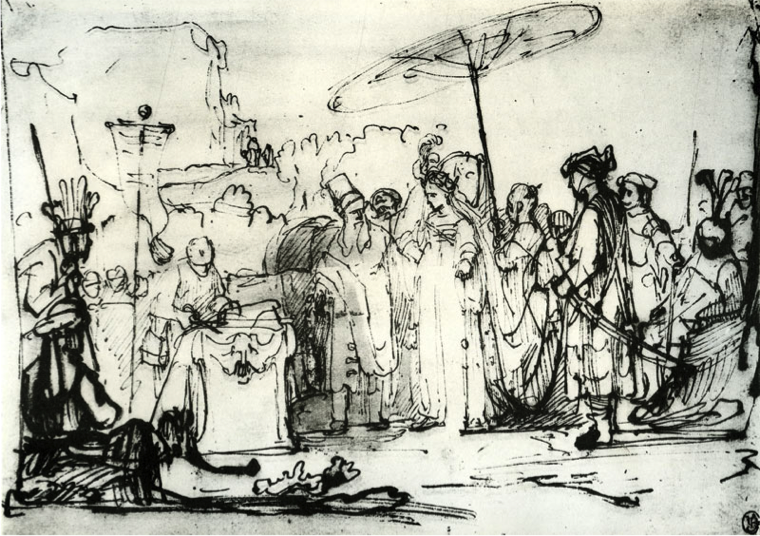
7th Century BCE South Arabian Inscription Documenting Trade between Sheba and the "towns of Judah"

This bronze inscription found in southern Arabia,
the land of Sheba, mentions a trading expedition of the kingdom of Sabaea
(Biblical Sheba) to the “towns of Judah.”
The artifact is dated to the end of
the 7th century BCE, after the time of Solomon, though it shows the
plausibility of the contact between Israel and the land of Sheba.
This inscription mentions a trading expedition of the kingdom of Sabaea (Biblical Sheba) to ’HGR YHD," translating to the “towns of Judah.”
Photo by André Lemaire
Trade Route from Sheba
Biblical Archaeology Society
King Solomon’s Wealth
1 Kings 10:14-16
"The weight of gold that came to Solomon each year was 666 talents…”
“King Solomon made two hundred large shields of hammered gold; six hundred shekels of gold went into each shield.”
The Fame of King Solomon’s wealth reached far and wide. The Bible relates in 1 Kings 10:14-16:
"The weight of gold that came to Solomon each year was 666 talents…”
“King Solomon made two hundred large shields of hammered gold; six hundred shekels of gold went into each shield.”
The Death of King Solomon,
c. 930 BCE
1 Kings 11:42-43
Thus the time that Solomon reigned in Jerusalem over all Israel was forty years.
And Solomon rested with his fathers and was buried in the city of his father David.
King Solomon's wives turned
his heart from fully serving G-d in his old age, causing him to also practice
idolatry.
This cast a shadow over the future of his kingship. The Bible
relates:
1 Kings 11: 11-13
Wherefore the L-RD said unto Solomon: 'Forasmuch as this was with
you, and you did not keep My covenant and My statutes which I have commanded
you, I will surely rend the kingdom from you and will give it to your servant.
But I will not do it in your days, for David your father's sake; but I will
rend it out of the hand of your son. But I will not rend away all the kingdom,
but I will give one tribe to your son; for the sake of David my servant, and
for Jerusalem's sake which I have chosen.'
King Solomon died around 930 BCE
1 Kings 11:42-43
Thus,
the time that Solomon reigned in Jerusalem over all Israel was forty years. And
Solomon rested with his fathers and was buried in the city of his father David.
Solomon's Kingdom is Divided into the Northern Kingdom of Ten Tribes of Israel and the Southern Kingdom of Judea and Benjamin
1 Kings 11:31
Prophet Ahijah of Shilo said: “…for this is what the L-RD, the G-d of Israel, says: ‘Behold, I will tear the kingdom out of the hand of Solomon, and I will give you (Jeroboam I) ten tribes (leaving the tribes of Judea and Benjamin to Rehoboam, the son of Solomon).”
1 Kings 11:31
Prophet Ahijah of Shilo said: “…for this is what the L-RD,
the G-d of Israel, says: ‘Behold, I will tear the kingdom out of the hand of Solomon, and I will give you (Jeroboam) ten tribes” (leaving the tribes of Judea and Benjamin to
Rehoboam, the son of Solomon).
Wikipedia
Jeroboam's Idolatry
1 Kings 12:28-29
The king (Jeroboam I) made two golden calves…
One he set up in Bethel, and the other in Dan.
Shortly after the death of Solomon, political catastrophe struck the country, tearing it apart. The northern tribes revolted against the Davidic dynasty, centred in Jerusalem, and now represented by Solomon’s weak and arrogant son, Rehoboam. They succeeded, setting up their own state which they called Israel. Jeroboam set up two centres of idol worship by placing two golden calves; one in Bethel and one in Dan, preventing the House of Israel to worship in Jerusalem.
1 Kings 12: 30
The people walked as far as Dan to worship before one of the calves…
Bronze Bull from Samaria, 12th Century BCE
Israel Museum / Israel Antiquities Authority
The Sacrificial Altar at Tel Dan
1 Kings 12:30
The people walked as far as Dan to worship before one of the calves.

Excavations at the site of Tel Dan, near modern-day Israel’s northern border, uncovered a cultic precinct. It consists of a massive stone platform with an associated area for sacrifices and storage rooms. The dates of construction and destruction are derived from biblical and Assyrian texts.
King Jeroboam likely built the precinct in the 10th century BCE as seen in the book of 1 Kings chapters 12 to 29. It was later destroyed by the Assyrian army under Tiglath-pileser III in 734 BCE.
Drone video of Tel Dan by Ardon Bar-Hama
Pharaoh Shoshenq (Shishak)
Takes King Solomon’s Gold,
925 BCE
1 Kings 14:25-26
In the fifth year of King Rehoboam, Shishak king of Egypt attacked Jerusalem. He carried off the treasures of the temple of the L-rd and the treasures of the royal palace. He took everything, including all the gold shields Solomon had made.
In this wall carving at the Temple of Amun in Karnak, Egypt, Shoshenq boasts of 90 cities he conquered in the land of Israel, including Megiddo, Gibeon and Migdol.
In the year 925 BCE, Pharaoh Shoshenq or Shishak, raided the
Temple and took King Solomon’s Gold
1 Kings 14:25-26
In the fifth year of King Rehoboam, Shishak king of Egypt attacked
Jerusalem. He carried off the treasures
of the temple of the L-RD and the treasures of the royal palace. He took everything, including all the gold
shields Solomon had made.
In
this wall carving at the Temple of Amun in Karnak, Egypt, Shoshenq boasts of 90
cities he conquered in the land of Israel, including Megiddo, Gibeon and
Migdol.
Wikimedia Commons
Shoshenq's Campaign Through Israel and Judah, 925 BCE
Places Mentioned in Shoshenq’s Inscription Include Many Cities in Israel:
- Fort Abram (possibly Beersheba*)
- Adoraim—2 Chronicles 11:9
- Ayalon—Joshua 10:12
- Beth-Horon—1 Kings 9:17
- Beth-Shean—1 Kings 4:12
- Gath—1 Samuel 5:8
- Gibeon—1 Chronicles 21:29
- Megiddo—1 Kings 4:12 (Armageddon)
- Rehov—Joshua 19:28
- Soroh—Joshua 15:35
- Taanach—1 Kings 4:12
Shoshenq's Campaign Through Israel and Judah, 925 BCE
Places mentioned in Shoshenq’s inscription include many cities in Israel:
Fort Abram (possibly Beersheba*)
Adoraim—2 Chronicles 11:9
Ayalon—Joshua 10:12
Beth-Horon—1 Kings 9:17
Beth-Shean—1 Kings 4:12
Gath—1 Samuel 5:8
Gibeon—1 Chronicles 21:29
Megiddo—1 Kings 4:12
Rehov—Joshua
19:28
Soroh—Joshua 15:35
Ta’anach—1 Kings 4:12
Biblical Archaeology Society



Pharaoh Shishak’s Stele Uncovered at Megiddo (Armageddon)
Dating to about 925 BCE, this 15-inch stone fragment discovered at Megiddo reads, “Amun’s beloved, Shishak [I].”
The stele fragment confirms Shishak’s encounter with Israel and Judea that is detailed on the inscription at the Temple of Amun in Karnak.
Dating to about 925 BCE, a 15-inch stone fragment was discovered
at Megiddo that reads, “Amun’s beloved, Shishak [I].”
The
stele fragment confirms Shishak’s encounter with Israel and Judea that is
detailed and cross-referenced on the inscription at the Temple of Amun in Karnak.
University of Chicago Oriental Institute
Shishak's Son, OsorkonI, Donated Solomon’s Gold,
921 BCE
Shishak’s son King Osorkon I of Egypt in 921 BCE recorded gifts to the gods, including 383 tons of gold and silver. This fragment from a pillar in a temple at Bubastis, shows itemized lists of gifts to each god and goddess of Egypt.
In 921 BCE Shishak’s son King Osorkon the 1st of Egypt recorded gifts to the gods,
including 383 tons of gold and silver, some most likely from King Solomon's
gold that was looted during Shishak's conquest.
This
fragment from a pillar in a temple at Bubastis shows itemized lists of gifts to
each god and goddess of Egypt.

Temple of Bubastis,
Egypt Exploration Fund, 1890
created with
WordPress Website Builder .